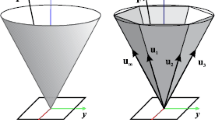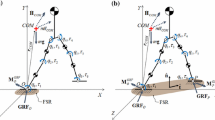Abstract
The paper discusses the complex problem of assessing online the static equilibrium of statically-indeterminate climbing and walking robots (CLAWARs) with quasi-static locomotion. The method proposed is general and works for whatever number of legs and ropes operated by actuated winches connecting the robot to the environment. The configuration of the robot is assigned. First, the compliance of the robot body, of the legs and the compliances of the ground and the ropes are modeled as localized elasticities. The static equilibrium problem of the resulting model is statically-determinate under the hypothesis that the foot and rope points (where the ropes are fixed to the robot body) are joined to the ground by bilateral constraints. Since these constraints are unilateral (the feet are contact points and can detach from the ground, and the ropes can become slack), it is necessary to apply an iterative solving procedure in order to solve the static equilibrium problem. The method presented in the paper is a fast and effective alternative to nonlinear analysis of a finite element model of the robot at any assigned configuration. As an example, we consider the case of the heavy-duty CLAWAR Roboclimber.
Similar content being viewed by others
References
Saranli, U., Buehler, M., and Koditschek, D.E. 2001. Rhex: A simple and highly mobile hexapod robot. Int. J. of Robotics Research, 20(7):616–631.
Gonzalez de Santos, P., Galvez, J.A., Estremera, J., and Garcia, E. 2003. Silo4—a true walking robot for the comparative study of walking machine techniques. IEEE Robotics and Automation Magazine, 10(4):23–32.
Scholl, K-U., Gafb mann, B., and Berns, K. 2001. Locomotion of LAURON III in rough terrain. In IEEE/ASME Int. Conf. on Advanced Intelligent Mechatronics, Como, Italy, July 8–11.
Apostolopoulos, D. and Bares, J. 1995. Locomotion configuration of a robust rappelling robot. In IEEE Int. Conf. on Intelligent Robots and Systems, Human Robot Interaction and Cooperative Robots IROS’95, Vol. 3, pp. 280–284.
Krishna, M., Bares, J., and Mutschler, E. 1997. Tethering system design for Dante II. In IEEE Int. Conf. on Robotics and Automation, Vol. 2, pp. 1100–1105.
Wettergreen, D., Pangels, H., and Bares, J. 1995. Behavior-based gait execution for the Dante II walking robot. In Int. Conf. on Intelligent Robots and Systems, Pittsburgh, PA, USA, August 5–9, pp. 274–279.
Song, S.M. and Waldron, K.J. 1989. Machines That Walk: the Adaptive Suspension Vehicle. MIT Press.
Ting, L.H., Blickhan, R., and Full, R.J. 1994. Dynamic and static stability in hexapodal runners. Experimental Biology, 197(1):251–269.
Hirose, S., Yoneda, K., and Tsukagoshi, H. 1997. TITAN VII: quadruped walking and manipulating robot on a steep slope. In IEEE Int. Conf. on Robotics and Automation, Albuquerque, NM, USA, April 20–25, pp. 494–500.
The roboclimber partnership. Roboclimber 2003. In P. Fiorini, (ed.), 1st Int. Workshop on Advances in Service Robotics ASER03, Bardolino, Italy, March 13–15, pp. 57–64.
Molfino, R.M., Armada, M., Cepolina, F., and Zoppi, M. 2005. Roboclimber, the 3 tons spider. Int. Jour. Industrial Robots, 32(2):163–170.
Cepolina, F., Moronti, M., Sanguineti, M., Zoppi, M., and Molfino, R.M. 2006. Roboclimber versus landslides. Int. Jour. IEEE Robotics & Automation Magazine, 13(1):Under the press.
Fukushima, E.F., Kitamura, N., and Hirose, S. 2001. Development of tethered autonomous mobile robot systems for fieldworks. Advanced Robotics, 15(4):481–496.
Hirose, S. and Fukushima, E.F. 2002. Snakes and strings: New robotic components for rescue operations. In 8th Int. Symp. on Experimental Robotics ISER’02, page CD proceedings, Sant’Angelo d’Ischia, Italy, July 8–11.
Dimentberg, F.M. 1965. The screw calculus and its applications in mechanics. Technical Report Technical Report FTD-HT-23-1632-67, Foreign Technology Division, Wright-Patterson Air Force Base.
Ghafoor, A. and Kerr, D.R. 1992. n-grasp robotic fine motion with frictionless elastic point contacts. Proc. Inst. Mech. Eng., Part C: J. Mech. Eng. Sci., 206:41–47.
Griffis, M. and Duffy, J. 1993. Global stiffness modelling of a class of simple compliant coupling. Mech. Mach. Theory, 28(2):207–224.
Ciblak, N. and Lipkin, H. 1994. Asymmetric cartesian stiffness for the modelling of compliant robotic systems. In Proc. ASME 23rd Biennial Mech. Conf., Des. Eng., Vol. 72, New York, NY, USA.
Ciblak, N. 1998. Analysis of Spatial Stiffness and Applications. Ph.D. dissertation, Georgia Institute of Technology, Georgia, USA.
Ciblak, N. and Lipkin, H. 1998. Synthesis of stiffness by springs. September 11–14.
Zefran, M., Kumar, V., and Croke, C. 1999. Metrics and connections for rigid body kinematics. Int. J. Robot. Res., 18(2):243–258.
Zefran, M. and Kumar, V. 2002. A geometrical approach to the study of the cartesian stiffness matrix. ASME J. of Mechanical Design, 124:30–38.
Ghafoor, A., Dai, J.S., and Duffy, J. 2004. Stiffness modelling of the soft-finger contact in robotic grasping. ASME J. of Mechanical Design, 126:646–656.
Hiller, M., Schuster, C., and Adamski, D. 1997. Fasim_C++—a versatile developing environment for vehicle dynamics simulation. Int. J. of Crashworthiness, 2(1):91–105.
Schneider, M. and Müller, J. 1999. Force based motion control of the walking machine alduro using exact linearization methods. In IEEE/ASME International Conference on Advanced Intelligent Mechatronics, Atlanta, Georgia, USA, September 19–23, pp. 537–542.
Schneider, M. Miiller, J., and Killer, M. 2000. Modeling, simulation, and model-based control of the walking machine alduro. IEEE/ASME Transactions on Mechatronic, 5(2):142–152.
Moronti, M. Sanguineti, M., Zoppi, M., and Molfino, R. 2004. Roboclimber: proposal for online gait planning. In 7th Int. Conf. on Climbing and Walking Robots CLAWAR04, Madrid, Spain, September 22–24.
Richard, E. and Vivalda, J.C. 2002. Mathematical analysis of stability and drift behavior of hydraulic cylinders driven by a servovalve. ASME J. of Dynamic Systems, Measurement, and Control, 124:206–213.
Author information
Authors and Affiliations
Corresponding author
Rights and permissions
About this article
Cite this article
Zoppi, M., Molfino, R. Equilibrium analysis of multi-limbs walking and climbing robots. Auton Robot 21, 199–210 (2006). https://doi.org/10.1007/s10514-006-7275-9
Published:
Issue Date:
DOI: https://doi.org/10.1007/s10514-006-7275-9




